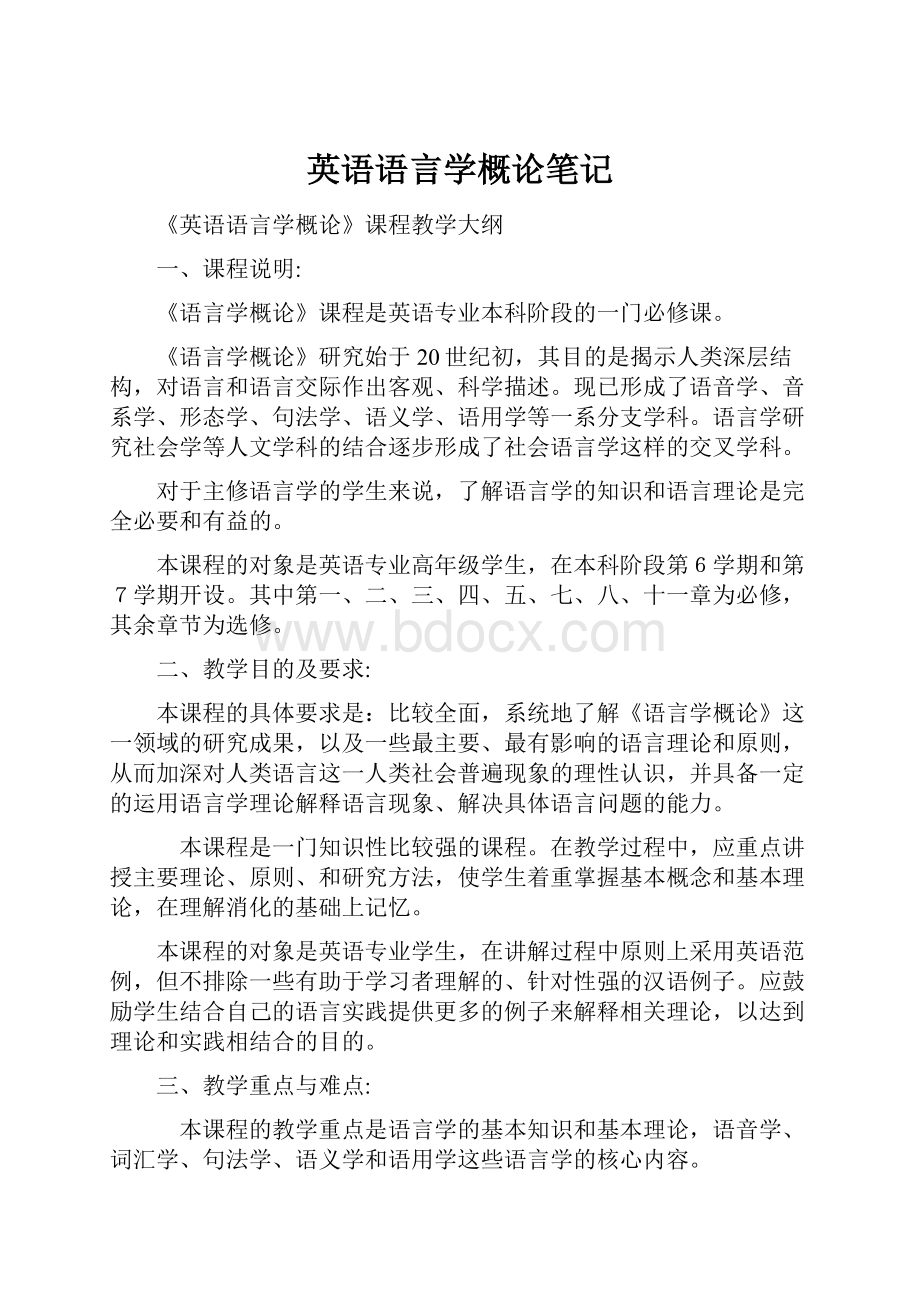英语语言学概论笔记.docx
《英语语言学概论笔记.docx》由会员分享,可在线阅读,更多相关《英语语言学概论笔记.docx(133页珍藏版)》请在冰豆网上搜索。

英语语言学概论笔记
《英语语言学概论》课程教学大纲
一、课程说明:
《语言学概论》课程是英语专业本科阶段的一门必修课。
《语言学概论》研究始于20世纪初,其目的是揭示人类深层结构,对语言和语言交际作出客观、科学描述。
现已形成了语音学、音系学、形态学、句法学、语义学、语用学等一系分支学科。
语言学研究社会学等人文学科的结合逐步形成了社会语言学这样的交叉学科。
对于主修语言学的学生来说,了解语言学的知识和语言理论是完全必要和有益的。
本课程的对象是英语专业高年级学生,在本科阶段第6学期和第7学期开设。
其中第一、二、三、四、五、七、八、十一章为必修,其余章节为选修。
二、教学目的及要求:
本课程的具体要求是:
比较全面,系统地了解《语言学概论》这一领域的研究成果,以及一些最主要、最有影响的语言理论和原则,从而加深对人类语言这一人类社会普遍现象的理性认识,并具备一定的运用语言学理论解释语言现象、解决具体语言问题的能力。
本课程是一门知识性比较强的课程。
在教学过程中,应重点讲授主要理论、原则、和研究方法,使学生着重掌握基本概念和基本理论,在理解消化的基础上记忆。
本课程的对象是英语专业学生,在讲解过程中原则上采用英语范例,但不排除一些有助于学习者理解的、针对性强的汉语例子。
应鼓励学生结合自己的语言实践提供更多的例子来解释相关理论,以达到理论和实践相结合的目的。
三、教学重点与难点:
本课程的教学重点是语言学的基本知识和基本理论,语音学、词汇学、句法学、语义学和语用学这些语言学的核心内容。
本课程的教学难点是音韵学理论、句法结构和各个语言学流派的理论观点及其局限性。
四、与其它课程的关系:
本课程是一门主干性课程。
与其相关的课程,如语法学、词汇学和语体学等都是语言学的分支,属于选修课程。
五、学时与学分:
学时:
72学时
学分:
4学分
六、教学内容:
第一章绪论
本章主要教学内容:
1.语言学习的意义。
2.语言的定义。
3.语言的定义特征。
4.语言的起源。
5.语言的功能。
6.语言学的定义。
7.语言学的核心内容。
8.宏观语言学的定义及分支。
9.语言学研究中的重要概念区分。
本章教学目的和要求:
本章是全书的绪论。
学习的目的是认识语言学的性质,以及人类语言的本质和特点。
要求学生认知、理解语言学的的研究对象,语言学的各个分支,明晰语言学研究中几对基本概念的区别。
本章教学重点及难点:
1.语言定义和区别性特征。
2.语言的功能。
3.几对重要概念的区分。
4.语言的区别性特征。
5.几对重要概念的区分。
第二章语言声音
本章主要教学内容:
1.发声与感知。
2.发音器官。
3.音标。
4.元音及辅音。
5.宽式音标窄式音标。
6.音位理论。
7.音韵的过程。
8.区别性特征。
9.音节和重读的概念及功能作用。
本章主要教学目的及要求:
本章的中心是语音,要求对各种发音器官有所了解。
对英语的元音、辅音的描述,分清宽式音标和窄式音标,以及音韵学的一些基本概念和基本规律。
二.本章教学重点及难点:
本章的教学重点是语音学的概念及分类,发音器官,元音及辅音的定义和分类方法,宽式音标和窄式音标,音位理论,区别性特征,重读的概念及功能。
第三章词汇
一.本章主要教学内容:
1.单词的概念。
2.构词法。
1)词素和形态学。
2)词素类型。
3)曲折变化和单词构成。
4)音韵学和形态学的对照。
3.词汇变迁。
二.本章教学目的及要求:
本章要求了解语素这个概念;掌握英语常见的构词法;了解词汇的历史变迁。
三.本章教学重点及难点:
1.词素的概念和词素的类型、曲折变化、词汇的变迁。
2.词素的概念、词素变体、词语的三层含义和音韵学与形态学的对照。
第四章句法学
本章主要教学内容:
1.传统语法包括数、格等语法范畴。
2.结构主义语法。
3.生成语法(可结合附录中有关生成语法的内容)。
4.功能语法。
本章教学目的及要求:
本章从传统语法、结构主义语法、生成语法和功能主义语法四个角度阐述了句法学的主要内容。
要求学生了解这四种方法的具体内容以及一些重要的概念,并深刻认识到语言的语法体系是一套高度抽象自律性规则系统、句子的线性与层次性、深层结构与表层结构等关系。
本章教学重点及难点:
传统语法中的数、格、性时态和语态、结构语法中的直接成分分析法和向心结构、离心结构、生成语法中的深层结构和表层结构。
第五章意义
本章主要教学内容:
1.意义的意义。
2.所指理论。
3.意义关系。
4.成分分析。
5.句子意义。
本章教学目的及要求:
本章对意义进行研究。
要求学生对几种主要的对意义研究的途径有所了解。
明析词汇与词汇之间和句子与句子之间的关系,了解近代语言学中对词义研究的重要方法。
本章教学重点及难点:
本章的教学重点是:
所指理论、意义关系和成分分析。
本章的教学难点是:
所指理论和成分分析。
句子意义这一部分内容可用于补充阅读材料。
第七章语言、文化、社会
本章主要教学内容:
1.语言与文化的关系。
1)语言和文化如何关联。
2)萨皮尔-沃夫假说。
3)个案研究。
4)文化在语言学研究中的地位。
5)文化在语言课堂教学中的作。
6.语言与社会的关系和社会语言学。
本章教学目的及要求:
本章重点教授语言和文化、社会的关系,使学生对语言现象以及附带的社会、文化内涵产生兴趣,并了解一些相关的理论。
本章教学重点及难点:
1.萨皮尔-沃夫假说、文化在语言课堂教学中的作用、社会语言学的定义和研究范围、社会语言学的应用。
2.萨皮尔-沃夫假说、文化在语言课堂中的作用及社会语言学的概念。
第八章语言使用
本章主要教学内容:
1.言语行为理论。
2.会话含义理论。
3.其他理论。
本章教学目的及要求:
本章重点讲授语用学的概念和著名的语用学理论、原则和研究成果。
要求学生对这些理论、原则有初步的了解,并能用来解释一些生活中语言现象。
本章教学重点及难点:
1.谚语行为理论、言内行为、言外行为、言后行为、合作原则、会话含义。
2.言语行为理论、违反合作原则所产生的会话含义。
本章的第三部分作为补充材料供学生课外阅读。
第十一章语言学与语言教学
本章主要教学内容:
1.语言学和外语教学的关系。
2.不同的观点、理论对外语教学的影响。
3.大纲的制订。
4.语言学习。
5.错误分析。
6.测试。
本章教学目的及要求:
本章的中心内容是语言学和外语教学的关系,介绍了影响外语教学的几种语言学理论和实践教学活动中常见的问题及对应策略,要求学生了解基本理论、掌握分析、测试的基本方法。
建议师范类本科学生此章作为必修。
本章教学重点及难点:
1.各种语言学理论在语言教学中的指导作用、交际能力理论、教学大纲的制定、语言学习中的输入和中介语的产生、错误分析的步骤和方法、两种不同的测试方法、测试类型和要求、测试内容和形式。
2.结构主义语言学在语言教学中的作用、转换生成语言学的理论观点、功能语言学在语言教学中的应用。
Chapter1InvitationtoLinguistics
1.Definitionoflanguage
Languageisasystemofarbitraryvocalsymbolsusedforhumancommunication.
2.Disignfeatures:
Definition:
Designfeaturesrefertothedefiningpropertiesofhumanlanguagethatdistinguishitfromanyanimalsystemofcommunication
2.1Arbitrariness
Definition:
Thereisnologicalconnectionbetweenalinguisticsymbolandwhatthesymbolstandsfor.
Ontheotherhand,languageisnotentirelyarbitrary
a.onomatopoeticwords(rumble,bang,crash)
compoundwords(photocopy)
b.atthesyntacticlevel,thereisacertaindegreeofcorrespondencebetweenthesequenceofclausesandtherealhappening.Forexample,
Hecameinandsatdown.
Hesatdownandcamein.
Hesatdownafterhecamein.
c.convention:
thelinkbetweenalinguisticsignanditsmeaningisamatterofconvention
2.2Duality
Definition:
Dualitymeansthepropertiesofhavingthelevelsofstructures,suchthatunitsoftheprimarylevelarecomposedofelementsofthesecondarylevelandeachofthetwolevelshasitsownprinciplesoforganization
●Theterm”human”ismeanttospecifythatlanguageishuman-specific
●Discussthesaying“Languageishuman-specific”.Inotherwords,whatmakeslanguagedifferentfromanimals’systemofcommunication.Forexample,thebears’dancing.
●Languageisasystem,whichconsistsof2setsofstructures.Atthelowerorbasiclevelthereisastructureofsounds,whicharemeaninglessbythemselves.Butthesoundsoflanguagecanbegroupedandregroupedintoalargernumberofunitsofmeaning,whicharefoundatthehigherlevelofthesystem.
●Sounds→words→phrases→sentences
●Thelowestlevelconsistsofdozensofbitsofmeaninglesssoundswhichoccurinchumpsthatwecallsyllables.
2.3Creativity(Productivity)
Definition:
Languageiscreativeinthatitmakespossibletheconstructionandinterpretationofnewsignalsbyitsusers.
●Thethree-leggedwhitemonkeysleptonthebedofthekingofFrance.
●Gibboncalls-alimitedrepertoire
●Beedancing-onlytoindicatefoodsources
2.4Displacement
Definition:
Languagecanbeusedtorefertocontextsremovedfromtheimmediatesituationsofthespeaker.
●Humanlanguagesenabletheiruserstosymbolizeobjects,eventsandconceptswhicharenotpresent(intimeandspace)atthemomentofcommunication.
●Languagecanbeusedtorefertothingswhicharepresentornotpresent,realorimaginedmattersinthepast,present,orfuture,orinfar-awayplaces
2.5CulturalTransmission
Definition:
Languageisnotbiologicallytransmittedfromgenerationtogeneration.Thedetailsofthelinguisticsystemmustbelearnedbyeachspeaker.
2.6Interchangeability
Definition:
Interchangeabilitymeansthatanyhumanbeingcanbebothaproducerandareceiverofmessages.
3.FunctionsofLanguage
1)Informativefunction
Thisfunctionisthemajorroleoflanguage.
“Languageservesfortheexpressionofcontext:
thatis,ofthespeaker’sexperienceoftherealworld,includingtheinnerworldofhisownconsciousness”(Halliday)
2)Interpersonalfunction
Thisisthesocialuseoflanguage
Throughlanguagepeopleestablishandmaintaintheirstatusinasociety.
“Languageservestoestablishandmaintainsocialrules,whichincludethecommunicationrolescreatedbylanguageitself”(Halliday)
Theinterpersonalfunctionoflanguageisthefunctionofexpressingidentity.
3)Performativefunction(Whatdowedowhenusinglanguage)
Languageisusedtodothings
Thisperformativefunctionoflanguageistochangethesocialstatusofpersons.Forexample,inmarriageceremony,thesentencingofcriminals,thenamingofaship
4)Emotivefunction
Languageisusedtorevealsomethingaboutthefeelingsandattitudesofthespeaker.Forexample:
ejaculationssuchas”Goodheavens”;“myGod”;”I’mextremelysorryaboutit”
Itisusedtochangetheemotionalstatusofanaudiencefororagainstsomeoneorsomething.
Itcanbeentirelypersonalandtotallywithoutanyimplicationofcommunicationtoothers
5)Phaticcommunion
Itreferstothesocialinteractionoflanguage.
Whenlanguageisusedtoestablishanatmosphereormaintainsocialcontactratherthanforexchanginginformationorideas,itfulfillsthephaticfunction.Forexample:
farewells,commentsontheweather,greetings
Malinowski(马林诺夫斯基)—thesocialinteractionoflanguage.Itistomaintainacomfortablerelationshipbetweenpeoplewithoutinvolvinganyfactualcontent.
Eg.Ritualexchangesabouthealthandweather
6)Recreationalfunction
Theuseoflanguageisforthesheerjoyofusingit.
EgVerbaldueling
Poetrywriting
1.Linguistics
▪1.1Definition
▪1.2Majorbranchesoflinguistics
▪1.3Macrolinguistics
▪1.4Importantdistinctionsinlinguistics
▪1.1Definition
▪Linguisticsisthescientificstudyoflanguage.
▪Ittriestoanswerthefollowingquestions:
▪Whatislanguage?
▪Howdoeslanguagework?
▪Explanation:
▪“Scientific”meansthatitisbasedonthesystematicinvestigationoflinguisticdata,conductedwithreferencetosomegeneraltheoryoflanguagestructure.
▪“Study”meansinvestigation.
▪“Language”meanslanguagesingeneral,thatis,linguisticsstudiesnotanyparticularlanguage,butlanguagesingeneral.
▪1.2Majorbranchesoflinguistics
▪1.2.1Phonetics
▪Phoneticsstudieshowspeechsoundsareprodudced,transmitted,andperceived.Itincludesthreeparts:
▪Articulatoryphonetics
▪Acousticphonetics
▪Auditoryphonetics
▪1.2.2Phonology
▪Phonologyisthestudyofthesoundpatternsandsoundsystemsoflanguages.
▪Phonemeisthedepartingpointofthephonologicalstudy.Itisthesmallestlinguisticunitofsoundthatcansignaladifferenceinmeaning.Forexample,
pin,bin,tin,din--/p,b,t,d/arephonemeswhichcandistinguishmeaningsofthesewords.
▪Thenwhatistherelationbetweenphoneticsandphonology?
ThinkaboutthisquestionandwewilldiscussitinChapter2.
▪1.2.3Morphology
▪Morphologystudiestheinternalstructureofwordsandtherulesbywhichwordsareformed.
▪Morphemesarethesmallestmeaningfulunitsinalanguage.
▪1.2.4Syntax
▪Syntaxisthestudyoftherulesgoverningthewayswordsarecombinedintosentencesinalanguage.
▪Wordsareorganizedintostructuresmorethanjustwordorder,e.g.,
▪A.Thechildrenwatched[thefireworkfromthehill].
▪B.Thechildrenwatched[thefirework][fromthehill].
▪1.2.5Semantics
▪Semanticsisthestudyofmeaning.
▪Itstudiesthemeaningsoflinguisticunitswithoutconcerningtheinfluenceofthecontextofsituation,i.e.,itstudiesthede-contextualizedmeaning.
▪1.2.6Pragmatics
▪Pragmaticsisthestudyofmeaningincontext.(Thenwhatisthedifferencebetweensemanticsandpragmatics?
)
▪Pragmaticsisconcernedwiththewaylanguageisusedtocommunicateratherthanwiththewaylanguageisinternallystructured
▪1.3Macrolinguistics–aninterdisciplinarynature
▪Itconcernswiththerelationbetweenlanguageandotherdisciplineswhicharealsopreoccupiedwithlanguage,forexample,psycholinguistics,sociolinguistics,anthropologicallinguistics,computationallinguistics,neurolinguistics,appliedlinguistics,etc.
▪1.4Importantdistinctionsinlinguistics
▪1.4.1Descriptivevs.Prescriptive
▪Examples:
▪1.a)ItisI.
▪b)Itisme.
▪2.a)Whodidyouspeakto?
▪b)Whomdidyouspeakto?
▪3.a)Ihaven’tdoneanything.
▪b)Ihaven’tdonenothing
▪Descriptive–Thelinguisticstudyaimstodescribeandanalyzethelanguagepeopleactuallyuse.
▪Prescriptive–thelinguisticstudyaimstolaydownrulesfor“correctandstandard”behaviorinusinglanguage,i.e.totellpeoplewhattheyshouldsayandwhattheyshouldnotsay.
▪Descriptiveexplanationsofthethreeexamples:
▪1)TheLatinruleisnotuniversal.InEnglish,“me”isinformaland“I”isfelttobeveryformal.
▪2)“Whom”isuse